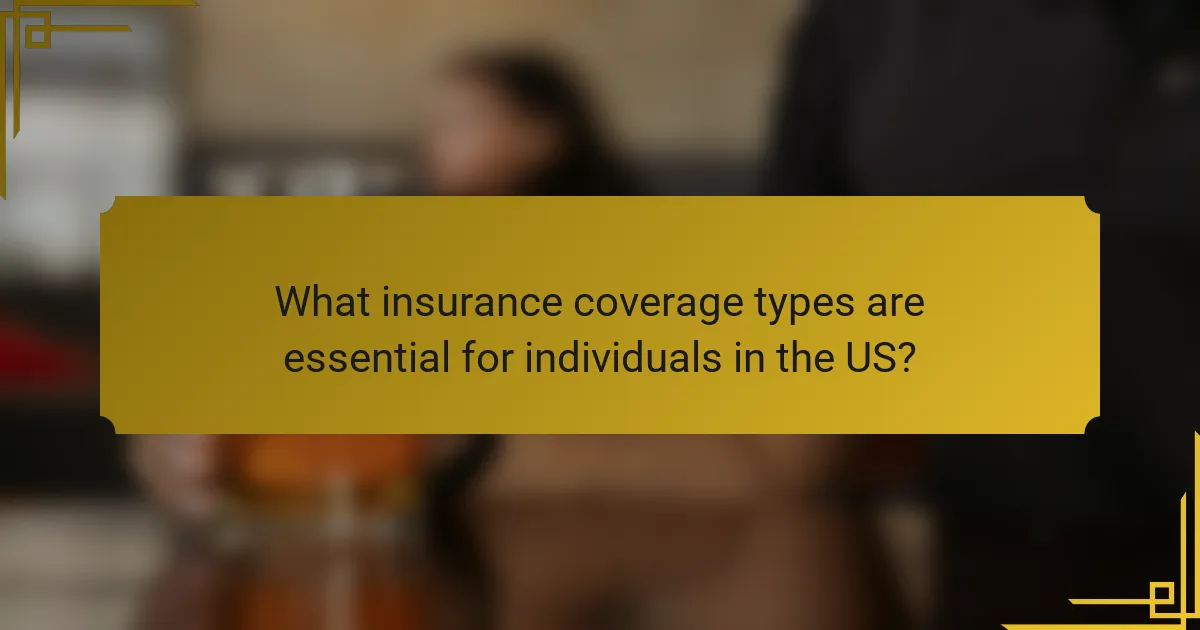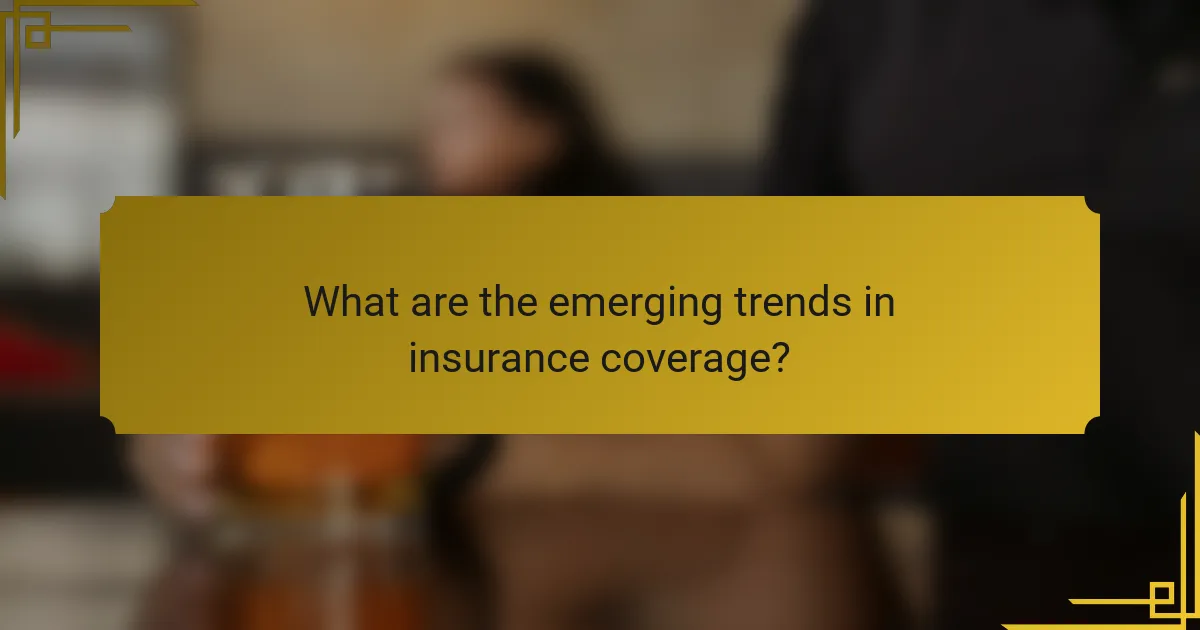Understanding insurance needs is crucial for individuals and businesses to safeguard against financial risks. Essential coverage types such as health, auto, homeowners, life, and disability insurance address specific liabilities, while liability insurance offers protection against legal claims. Effective risk management strategies further enhance financial security by identifying and mitigating potential risks.

What insurance coverage types are essential for individuals in the US?
Individuals in the US should consider several essential insurance coverage types to protect themselves from financial risks. These include health, auto, homeowners, life, and disability insurance, each addressing specific needs and potential liabilities.
Health insurance
Health insurance is crucial for covering medical expenses, including doctor visits, hospital stays, and prescription medications. In the US, individuals can obtain health insurance through employer-sponsored plans, government programs like Medicare and Medicaid, or by purchasing private insurance.
When selecting a health insurance plan, consider factors such as premiums, deductibles, co-pays, and the network of healthcare providers. It’s advisable to compare different plans to find one that balances coverage with affordability.
Auto insurance
Auto insurance protects against financial loss in the event of a car accident, theft, or damage. Most states require drivers to carry a minimum level of liability insurance, which covers damages to others in an accident you cause.
When choosing auto insurance, consider coverage types such as liability, collision, and comprehensive insurance. Evaluate your driving habits and the value of your vehicle to determine the appropriate coverage levels. Discounts may be available for safe driving records or bundling policies.
Homeowners insurance
Homeowners insurance provides financial protection against damage to your home and personal property due to events like fire, theft, or natural disasters. It typically includes liability coverage for accidents that occur on your property.
When purchasing homeowners insurance, assess the value of your home and belongings to ensure adequate coverage. Consider additional endorsements for specific risks, such as flood or earthquake coverage, which may not be included in standard policies.
Life insurance
Life insurance offers financial security to your beneficiaries in the event of your death. It can help cover living expenses, debts, and funeral costs, providing peace of mind for you and your loved ones.
There are two main types of life insurance: term and whole life. Term life insurance provides coverage for a specific period, while whole life insurance offers lifelong coverage with a cash value component. Evaluate your financial situation and long-term goals to determine the right type and amount of coverage.
Disability insurance
Disability insurance protects your income if you become unable to work due to illness or injury. This coverage is essential for maintaining financial stability during unforeseen circumstances that prevent you from earning a paycheck.
There are short-term and long-term disability insurance options. Short-term policies typically cover a few months of lost income, while long-term policies can provide benefits for several years or until retirement age. Assess your savings and expenses to determine how much coverage you need and consider employer-sponsored options if available.

How does liability insurance protect against risks?
Liability insurance protects individuals and businesses from financial losses resulting from legal claims or lawsuits. It covers legal fees, settlements, and damages awarded to third parties, helping to mitigate the financial impact of unforeseen incidents.
General liability insurance
General liability insurance provides coverage for claims related to bodily injury, property damage, and personal injury that occur on your premises or as a result of your business operations. This type of insurance is essential for businesses to protect against common risks, such as slip-and-fall accidents or damage caused by employees.
When considering general liability insurance, assess the specific risks associated with your business activities. Coverage limits typically range from hundreds of thousands to millions of dollars, depending on the size and nature of your operations. Ensure that your policy aligns with your business needs and local regulations.
Professional liability insurance
Professional liability insurance, also known as errors and omissions insurance, protects professionals from claims of negligence, errors, or omissions in the services they provide. This type of coverage is crucial for service-oriented businesses, such as consultants, lawyers, and healthcare providers, where the risk of making a mistake can lead to significant financial repercussions.
When selecting professional liability insurance, consider the specific services you offer and the potential risks involved. Coverage limits can vary widely, so it’s important to choose a policy that adequately protects your assets. Regularly review your coverage to ensure it reflects any changes in your business practices or regulatory requirements.

What are the key factors in risk management for businesses?
Key factors in risk management for businesses include identifying potential risks, assessing their impact, and implementing effective mitigation strategies. These steps help organizations minimize losses and ensure operational continuity.
Identifying potential risks
Identifying potential risks involves recognizing events or conditions that could negatively affect business operations. Common risks include financial uncertainties, legal liabilities, operational disruptions, and natural disasters.
Businesses should conduct regular risk assessments, utilizing tools like SWOT analysis or risk matrices to categorize and prioritize these risks. Engaging employees and stakeholders in this process can provide valuable insights into less obvious threats.
Assessing risk impact
Assessing risk impact requires evaluating the potential consequences of identified risks on business objectives. This assessment often considers factors such as financial loss, reputational damage, and operational delays.
Using qualitative and quantitative methods can help quantify risks. For instance, a financial risk might be assessed in terms of potential revenue loss, while reputational risks could be gauged through customer feedback and market perception.
Implementing risk mitigation strategies
Implementing risk mitigation strategies involves developing plans to reduce or eliminate identified risks. This can include transferring risk through insurance, implementing safety protocols, or diversifying supply chains.
Businesses should regularly review and update their risk management strategies to adapt to changing circumstances. Establishing a risk management team can facilitate ongoing monitoring and response to emerging risks.

How to choose the right insurance provider?
Choosing the right insurance provider involves assessing their coverage options, customer service, and financial stability. Prioritize providers that align with your specific needs and offer reliable support and security.
Comparing coverage options
When comparing coverage options, look for policies that meet your unique requirements, such as liability, property, or health insurance. Consider the extent of coverage, deductibles, and any exclusions that may apply.
For example, if you need auto insurance, evaluate whether the policy covers collision, comprehensive, and liability. A good rule of thumb is to ensure that the coverage limits are sufficient to protect your assets, typically aiming for limits that match or exceed your net worth.
Evaluating customer service
Customer service is crucial in choosing an insurance provider, as it affects your experience when filing claims or seeking assistance. Look for companies with a reputation for responsive and helpful support, which can often be assessed through online reviews and ratings.
Consider the availability of customer service channels, such as phone, email, and live chat. A provider that offers 24/7 support can be beneficial in emergencies, ensuring you receive assistance when you need it most.
Checking financial stability
Financial stability is essential when selecting an insurance provider, as it indicates their ability to pay out claims. Research the company’s financial ratings from agencies like A.M. Best or Standard & Poor’s, which assess their creditworthiness and stability.
Look for providers with strong ratings, typically in the A range, as this suggests they are well-positioned to handle claims. Additionally, consider the company’s history and reputation in the industry, as established providers are often more reliable.

What are the emerging trends in insurance coverage?
Emerging trends in insurance coverage reflect the industry’s adaptation to technology and changing consumer needs. Key developments include the integration of telematics in auto insurance and the rise of on-demand insurance models, both of which enhance personalization and flexibility for policyholders.
Telematics in auto insurance
Telematics involves using devices to monitor driving behavior, allowing insurers to offer personalized premiums based on actual driving data. This technology can track speed, braking patterns, and mileage, helping safe drivers potentially save on their premiums.
For example, a driver who consistently maintains safe speeds and avoids hard braking may see discounts of up to 30% on their insurance costs. However, consumers should be aware that sharing this data may raise privacy concerns and that not all insurers offer telematics programs.
On-demand insurance models
On-demand insurance allows consumers to purchase coverage for specific events or periods, providing flexibility that traditional policies may lack. This model is particularly popular for items like travel, rental cars, or even personal belongings, enabling users to activate and deactivate coverage as needed.
For instance, a traveler can buy insurance just for the duration of their trip, often at a lower cost than a full-year policy. However, consumers should carefully read the terms to understand coverage limits and exclusions, as on-demand policies may not cover all scenarios.
